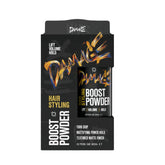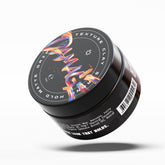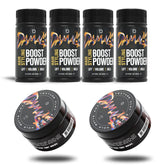Texture powder (sometimes called hair volume powder or hair styling powder) has become a go-to product for anyone looking to add instant lift, grit, and volume to their hair. However, it’s not uncommon to encounter clumping issues—those pesky knots or lumps that form when the powder doesn’t distribute evenly. If you’ve ever wondered, “Why does texture powder make my hair clump?” you’re not alone. This article dives deep into the science behind hair texture powders, the most common mistakes that lead to clumping, and the best practices to achieve a full-bodied style without the unwanted tangles.
In this guide, we’ll cover:
- What Is Texture Powder and How Does It Work?
- Why Does Hair Clump with Texture Powder?
- Top 10 Mistakes That Cause Clumping
- How to Avoid Clumps and Achieve Smooth Results
- Frequently Asked Questions
- Additional Tips for Using Texture Powder
Throughout, we’ll provide internal links to further resources on our site, so you can learn more about using texture powder effectively and explore our range of styling products.
1. What Is Texture Powder and How Does It Work?
1.1 The Basics
Texture powder is a finely milled product designed to add volume, definition, and a matte finish to the hair. Common ingredients include silica silylate, rice starch, or cornstarch, all of which create friction between your hair strands. This friction pushes the hair away from the scalp, producing instant lift and thickness. Think of texture powder as the “dry shampoo” for boosting volume—except it typically offers a stronger grip and a more pronounced texturizing effect.
If you’re new to texture powder, check out our
Step-by-Step Guide to Applying Hair Volume Powder
to learn the fundamentals of proper usage.
1.2 The Appeal of Texture Powder
- Immediate Volume: A few shakes at the roots can transform limp or flat hair in seconds.
- Matte Finish: If you dislike the shine of gels or pomades, you’ll appreciate the natural matte look.
- Lightweight Hold: Texture powder keeps hair from feeling stiff or crunchy, unlike some hairsprays and waxes.
- Oil Absorption: Many formulas help sop up excess oil, extending the life of your style between washes.
Despite these benefits, texture powder can be tricky if you apply too much, apply it incorrectly, or don’t factor in your specific hair type. Clumping is one of the main side effects of misuse, and we’ll explore exactly why that happens.
2. Why Does Hair Clump with Texture Powder?
2.1 The Science of Friction
Texture powder works by creating friction between hair strands, making them “stand apart” for added volume. However, when the powder accumulates in one area—or when it combines with leftover styling product, oil, or moisture—it can bind strands together too tightly. Instead of achieving airy volume, you get small lumps or crunchy sections.
2.2 Product Build-Up
If you’re layering multiple products (serums, creams, or oils) and then adding texture powder on top, clumping can occur. The powder may stick unevenly to oily spots or product residue, leading to patchy, tangled sections.
Over time, product build-up also weighs the hair down. The friction effect that makes texture powder so powerful can become your enemy if the strands are already coated with other substances, causing them to bunch rather than separate.
2.3 Moisture Mismatch
Moisture plays a critical role in how powders interact with your hair. If you apply hair styling powder to very damp or sweaty hair, it can absorb the moisture and form clumps. Similarly, extremely dry hair with static can cause the powder to “cling” in random spots. Maintaining a balanced level of dryness is key to even distribution.
2.4 Over-Application
Clumps can also arise simply from using too much product. Texture powder is highly concentrated; a little goes a long way. Sprinkling excessive amounts in one area not only leads to clumping but can also create a gritty, unpleasant feel.
3. Top 10 Mistakes That Cause Clumping
Understanding the reasons behind clumping can help you diagnose where things might be going wrong in your routine. Below are the 10 most common mistakes:
3.1 Applying Powder Directly to Wet or Damp Hair
Why It Clumps:
When your hair is wet or even slightly damp, powder particles can stick together and form dense clusters. Instead of distributing evenly, they bind into small lumps that cling to moist strands.
How to Avoid It:
Ensure your hair is at least 90% dry before reaching for the powder. Use a blow-dryer if necessary, or wait a few extra minutes after towel-drying.
Further Reading:
Check out our How to Prep Your Hair for Styling guide for more tips on achieving the ideal dryness level.
3.2 Using Too Much Powder in One Spot
Why It Clumps:
Excess powder in a concentrated area saturates those strands, leaving you with a chalky, sticky section of hair.
How to Avoid It:
- Lightly tap the bottle instead of shaking aggressively.
- Start with a small amount and build up gradually.
Pro Tip:
For instant volume that’s clump-free, consider Damage Hair’s Boost Powder, specifically formulated to distribute evenly and minimize the risk of clumping.
3.3 Neglecting to Distribute the Powder Properly
Why It Clumps:
Sprinkling the powder and not massaging or combing it through can lead to clusters. Hair near the scalp might receive a heavy dose, while the rest remains untouched.
How to Avoid It:
Use your fingertips to massage the powder into your roots. Gently brush or use a wide-tooth comb to spread the product further down if you want volume beyond the crown.
3.4 Mixing Texture Powder with Heavy Styling Products
Why It Clumps:
Styling creams, serums, and oils can create a “sticky base,” causing the powder to adhere in thick patches instead of light layers.
How to Avoid It:
Either skip the heavy products on days you use texture powder or choose water-based, lightweight formulas that won’t interfere with the powder’s distribution.
3.5 Overly Oily Hair
Why It Clumps:
Excess scalp oil can make certain sections of your hair more “tacky.” The powder quickly latches onto these areas, forming lumps.
How to Avoid It:
- Wash your hair with a clarifying shampoo if you have significantly oily roots.
- Use a small amount of dry shampoo before applying texture powder if you notice oiliness.
- Massage the scalp thoroughly to break up oil pockets, then lightly blow-dry.
3.6 Failing to Remove Previous Product Residue
Why It Clumps:
Product residue from gels, waxes, or hairsprays can create a sticky canvas for new powder. Layering new powder onto old buildup leads to uneven clumping.
How to Avoid It:
Incorporate a weekly clarifying wash or deeply cleanse your hair every few shampoos. Removing past build-up ensures the powder can distribute smoothly.
Internal Link:
Check out Our Guide to Weekly Hair Care for in-depth tips on removing product residue.
3.7 Applying Powder at the Wrong Stage in Your Routine
Why It Clumps:
Adding texture powder before blow-drying or other styling steps can disrupt the evenness, causing random pockets of clumping when heat is applied.
How to Avoid It:
Use your dryer or other styling tools first. Then, apply the powder last to “lock in” the volume and texturize the final look.
3.8 Rubbing Too Vigorously
Why It Clumps:
While massaging is essential, overdoing it can cause the powder to bunch up in certain areas—especially if your scalp is oily or you’re creating friction in the same spot repeatedly.
How to Avoid It:
Practice gentle, circular motions, focusing on even coverage. Think of it as distributing the powder, not scrubbing it into your scalp.
3.9 Neglecting to Break Up Clumps Immediately
Why It Clumps:
Once powder starts to clump, it can form mini “knots” in your hair that become harder to disperse later. If you ignore them, they often worsen.
How to Avoid It:
The moment you feel a knot or lump forming, lightly use your fingertips or a comb to break it up. A quick fix early on prevents bigger styling headaches down the road.
3.10 Using Low-Quality or Expired Products
Why It Clumps:
Not all texture powders are created equal. Some budget or expired formulas may contain binders or fillers that encourage clumping.
How to Avoid It:
Invest in a reputable, high-quality powder formulated for minimal residue and easy distribution. Damage Hair’s Boost Powder is specifically designed to reduce the risk of clumps, thanks to its ultra-fine texture and premium ingredients.
4. How to Avoid Clumps and Achieve Smooth Results
Now that you know the most common pitfalls, let’s explore actionable strategies to keep clumps at bay:
4.1 Adjust the Amount You Use
Always err on the side of less. You can build up volume progressively, but removing excess powder mid-style is far more challenging.
- Initial Application: Start with a sprinkle about the size of a dime on the crown.
- Assess: Look in the mirror; fluff your roots. If more volume is needed, apply a second, smaller dose.
- Spread: Use your fingertips to spread any excess to surrounding areas.
4.2 Prep Your Hair Correctly
- Clarify if Needed: If your hair feels oily or product-laden, consider a clarifying shampoo.
- Dry Thoroughly: Ensure your hair is fully dry or only slightly damp. Moisture can cause powder to clump faster.
- Lightweight Products: If you must use a pre-styling product, choose a light leave-in conditioner or volumizing spray that won’t weigh down the roots.
4.3 Master the Application Technique
Rather than dumping the powder directly onto your scalp:
- Section Strategically: Divide your hair into manageable sections at the crown and sides.
- Tap Gently: Tap the bottle a few times in each section rather than shaking out a large amount.
- Massage & Comb: Massage with fingertips, then consider using a wide-tooth comb to spread the product if you prefer a more uniform finish.
Further Learning:
For a detailed tutorial on technique, head over to our
How to Apply Hair Volume Powder
article, which includes step-by-step photos.
4.4 Minimize Excess Oils
Clumping often correlates to oily scalps or product residue:
- Scalp Treatments: Weekly scalp treatments or exfoliating scrubs can reduce oil build-up.
- Blotting Method: If you notice your roots getting greasy midday, gently blot them with a tissue before reapplying any styling powder or dry shampoo.
4.5 Use High-Quality Texture Powder
Opt for powders formulated with minimal fillers and a refined consistency. If your current powder causes constant clumping, it may be time to upgrade to a premium product like our
Boost Powder
which is engineered for smooth, even application and sweat-resistant performance.
5. Frequently Asked Questions
Below are some of the top inquiries we receive about texture powder and how to prevent clumping.
5.1 Can I Use Texture Powder on Curly Hair?
Absolutely. In fact, hair volume powder can help define curls and reduce frizz. Just be sure to distribute the product evenly by combing through or scrunching gently. Curly hair typically has natural volume, so you’ll want to use an even lighter touch to avoid clumps.
5.2 Is It Okay to Combine Texture Powder with Other Products?
Yes, but be strategic. Pairing texture powder with a heavy pomade or oil-based serum often leads to clumping. Instead, choose lightweight or water-based products for layering. If you do need a heavier product, apply it sparingly and let it settle before adding the powder.
5.3 How Often Should I Wash Out Texture Powder?
Daily washing might be excessive for some hair types, but you should cleanse your scalp thoroughly every few uses to prevent buildup. If your scalp feels heavy or your style isn’t achieving volume like it used to, it’s a clear sign you need a wash. Also consider using a clarifying shampoo once a week.
5.4 Does Texture Powder Damage Hair?
Used in moderation and with proper application, texture powder is generally safe. Overuse or pairing with excessive heat styling can stress the hair, but the powder itself is not inherently damaging. If you notice dryness, incorporate a nourishing conditioner or hair mask into your routine.
Internal Link:
Find helpful tips on balancing styling and hair health in our
Weekly Hair Care Guide.
5.5 Can I Reapply Texture Powder Throughout the Day?
Yes. If your style starts to fall flat or your roots become oily, sprinkle a small amount at the roots and fluff gently. However, be cautious not to over-apply. Instead, lightly break down any existing build-up with your fingers or a comb before adding more product.

6. Additional Tips for Using Texture Powder
6.1 Experiment with Different Techniques
Everyone’s hair is unique, so what works for one person might not work for another. Try:
- Upside-Down Application: Flip your hair forward, tap some powder at the roots, and massage.
- Spot Treatment: Only target areas where you need lift, such as the crown or specific flat spots.
- Blow-Dry After Application: If you want extra volume, apply the powder, then briefly blast your roots with a hairdryer on low to help set the style.
6.2 Consider Seasonal Adjustments
Humidity and temperature affect how the powder behaves:
- Hot, Humid Climates: Your scalp may produce more oil, so you’ll need less powder but more frequent reapplication.
- Dry, Cold Climates: Static can become an issue. A small amount of leave-in conditioner on the ends can help reduce static-related clumping.
6.3 Styling for Specific Hair Goals
- Short Hair: A tiny amount goes a long way for texturizing and giving a “messy” look.
- Medium or Long Hair: Target the crown and mid-lengths for balanced volume.
- Layered Cuts: Texture powder accentuates the different layers, so ensure you distribute it evenly to highlight each layer without tangles.
6.4 Don’t Forget to Condition
While texture powder isn’t as harsh as some chemical-laden styling products, your hair still needs nourishment.
- Use a quality conditioner focusing on mid-lengths and ends.
- A weekly deep-conditioning mask ensures that the friction-based mechanism of texture powder doesn’t dry your hair over time.
Conclusion
Texture powder can be a game-changer for achieving instant volume, a matte finish, and workable hold—especially for men and women who need that extra lift to perfect their style. However, the very properties that make hair volume powder so effective can also lead to clumping if misapplied. The good news is that most clumping issues stem from easily correctable mistakes: using too much product, applying it to damp or overly oily hair, layering it on top of heavy styling creams, or failing to distribute it evenly.
By following the strategies outlined in this article—starting with dry, product-free hair, applying small amounts at a time, choosing a high-quality powder, and making sure to break up any clumps early—you can enjoy the full benefits of texture powder without worrying about unwanted tangles or lumps. For a smoother, more consistent experience, consider upgrading to
Damage Hair’s Boost Powder, which has been meticulously formulated to minimize clumping and maximize volume in just a few shakes.
If you found this guide helpful, you can learn even more about hair styling powders, best practices, and how to maintain healthy hair in our blog section:
Armed with the knowledge from these resources, you’ll be well on your way to transforming flat, lifeless hair into a bold, voluminous style—free of clumps and full of confidence.








